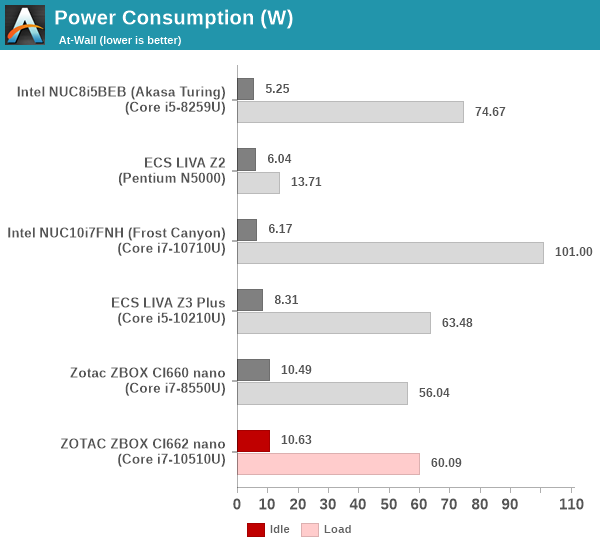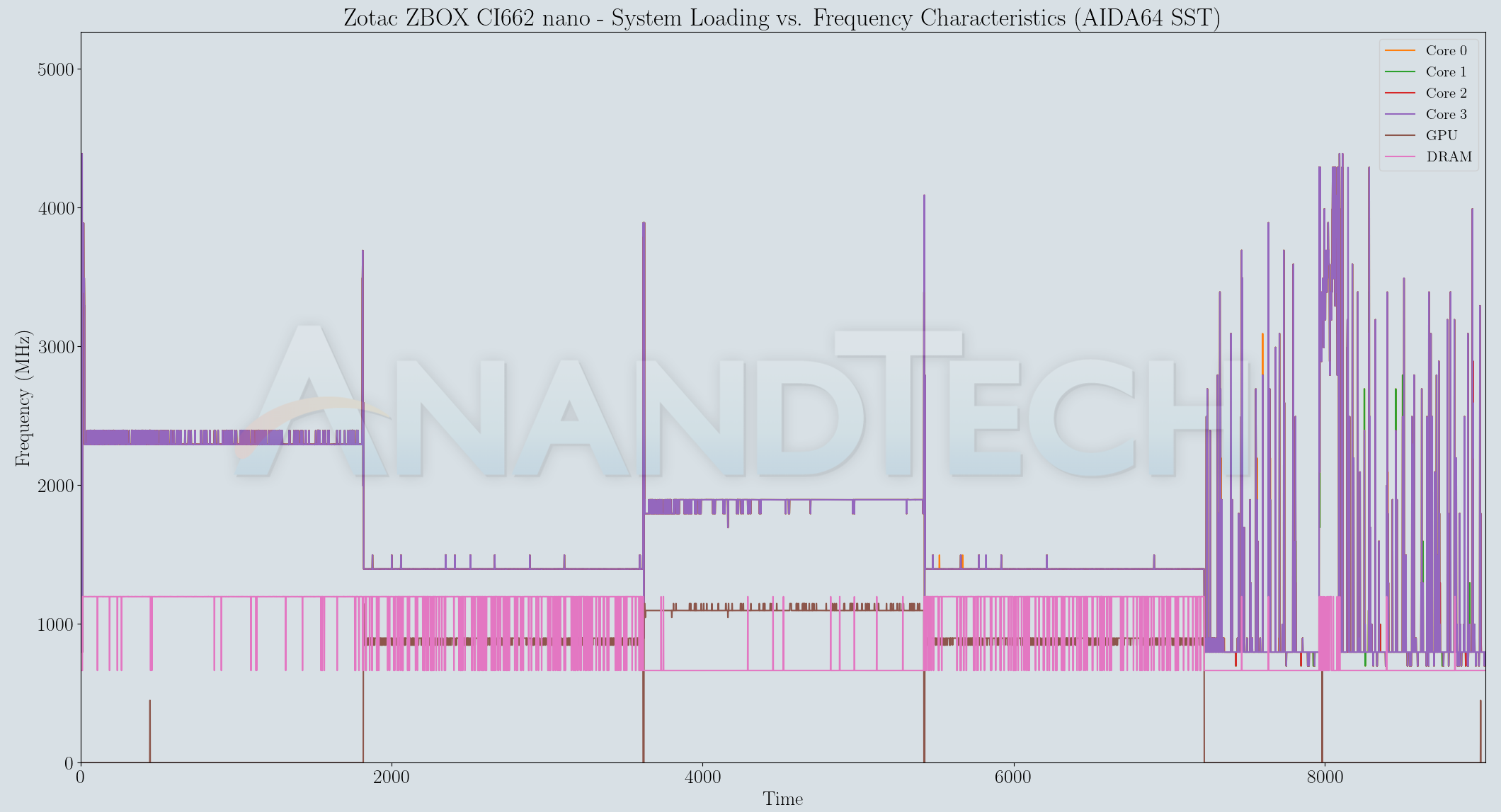Zotac ZBOX CI662 nano Fanless mini-PC Review: Second Stab at Silencing Succeeds
by Ganesh T S on January 5, 2021 8:00 AM EST- Posted in
- Systems
- Intel
- ZOTAC
- Fanless
- HTPC
- ZBOX
- Passive Cooling
- Mini-PC
- Comet Lake
Power Consumption and Thermal Performance
The power consumption at the wall was measured with a 4Kp60 non-HDR display being driven through the HDMI port. In the graphs below, we compare the idle and load power of the Zotac ZBOX CI662 nano with other low power PCs evaluated before. For load power consumption, we ran the AIDA64 System Stability Test as well as our custom stress test with Prime95 and Furmark, and noted the maximum power consumption at the wall.

The power consumption profile of the CI662 nano is essentially the same as that of the CI660 nano. The idling power is way too high for a system that uses a SATA SSD and DDR4-2400 DRAM. Given that other CML-U systems are able to have lower idling power numbers, Zotac should definitely go back and review their default BIOS configuration to determine the cause of this behavior.
Our thermal stress routine starts with the system at idle, followed by four stages of different system loading profiles using the AIDA64 System Stability Test (each of 30 minutes duration). In the first stage, we stress the CPU, caches and RAM. In the second stage, we add the GPU to the above list. In the third stage, we stress the GPU standalone. In the final stage, we stress all the system components (including the disks). Beyond this, we leave the unit idle in order to determine how quickly the various temperatures in the system can come back to normal idling range. The various clocks, temperatures and power consumption numbers for the system during the above routine are presented in the graphs below.
| Zotac ZBOX CI662 nano System Loading with the AIDA64 System Stability Test | |||

The frequencies of the CPU and GPU are at or above the rated clocks throughout the stress routine. The temperatures of different components are also in the safe zone - less than 80C for the CPU package and around 60C for the SSD (when it is subject to stress). The package power is 15W throughout the testing, and the cooling solution has no trouble keeping up with that - just the same as what we saw in the CI660 nano review.
| Zotac ZBOX CI662 nano System Loading with Prime95 and Furmark | |||

Under artificially stressful workloads like Prime95 and Furmark, the GPU is able to meet the rated clocks, but the CPU adjusts itself in simultaneous loading scenarios to ensure that the package power consumption doesn't go beyond 15W. Temperatures do not go beyond 80C for these workloads either.
The thermal solution employed by Zotac in the C-series since mid-2018 is quite effective in handling 15W TDP processors, as we noted in the CI660 nano review earlier and the CI662 nano above. The package temperature is maintained well below the 100C junction temperature even under sustained stressful workloads.










8 Comments
View All Comments
wr3zzz - Tuesday, January 5, 2021 - link
I am a huge fan of passively cooled PC but at this price point there is not much value proposition. I understand that there are no more Y-series CPU at the moment (love my HP Folio) but most notebook at $700 price point today has a silent fan profile if one were to use it as a HTPC. Also, this thing is not a looker either and for aesthetics I would rather have a notebook with display off as HTPC. For everything else its performance is no better than a notebook of equivalent value and I would trade the fan noise for actual utility of having the display and inputs in one unit.NUC has no chance if its value proposition is inferior to notebooks.
Operandi - Tuesday, January 5, 2021 - link
Yeah, I have to agree the value of this as a HTPC is absurd which is a shame as lit looks like it works quite well. And from the pics I think it actually looks alright (at least from pics) from ID perspective; much better than the ugly AF Intel NUCs.I got a pretty good deal on a older 8000 series NUC and put it in a passive Akasa case. Looks very cool, cools decently but still pretty expensive even if the NUC was way under retail.
Hulk - Tuesday, January 5, 2021 - link
My thoughts exactly. You can buy a laptop for less money. The price point is way off.Beside that huge miss it also needs a Tiger Lake processor for better performance and thermals/efficiency.
jeremyshaw - Tuesday, January 5, 2021 - link
I would even argue as a forward looking HTPC, the lack of Tiger Lake kills it. No hardware AV1 decode on these old Skylake+++ CPUs.Jorgp2 - Tuesday, January 5, 2021 - link
There's always the Atom based NUCs if you just want an HTPC.Hopefully the Tremont based NUCs will have 4K 10bit HDR output this time.
DigitalFreak - Tuesday, January 5, 2021 - link
I need a NUC form factor PC with support for DisplayPort 1.4. So far the only one I've found is the ASUS PN50, and it's a bit on the chunky side. Intel was supposed to come out with the Gen 11 NUCs with Xe graphics in December, but that didn't happen.satai - Tuesday, January 5, 2021 - link
There are boutique options like quietpc.com but it isn't a cheap option.Anyway I agree with you - I wouldn't buy a new device without 4k@120 support.